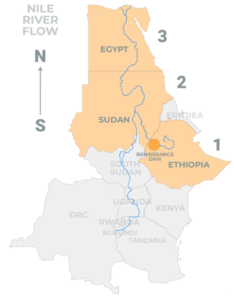In news
Recently, Saudi Arabia supported Egypt, Sudan ‘water rights’ in the GERD dam dispute with Ethiopia.
About Grand Ethiopian Renaissance Dam (GERD)
- It is a massive hydropower dam built by Ethiopia on the Blue Nile, the Nile River’s main tributary.
- The name that the Blue Nile river takes in Ethiopia (“Abay”) is derived from the Ge’ez word for ‘great’ to imply its being ‘the river of rivers.
- It has been under construction since 2011.
- It is formerly known as the Millennium Dam and sometimes referred to as Hidase Dam.
- The dam is in the Benishangul-Gumuz Region of Ethiopia, about 45 km east of the border with Sudan.
- The primary purpose of the dam is electricity production to relieve Ethiopia’s acute energy shortage and for electricity export to neighboring countries.
- With a planned installed capacity of 6.45 gigawatts, the dam will be the largest hydroelectric power plant in Africa when completed, as well as the seventh largest in the world.
- GERD is the source of an almost decade-long diplomatic standoff between Ethiopia and downstream nations Egypt and Sudan.

- The issue came up as Tunisia had submitted a draft resolution to the UN Security Council, calling on Ethiopia to cease filling the GERD’s reservoir.
- The resolution calls on Egypt, Ethiopia, and Sudan to resume negotiations at the joint invitation of the Chairperson of the African Union and the Secretary-General of the United Nations to finalise, within a period of six months.
- The resolution adds the agreement should “ensure Ethiopia’s ability to generate hydropower from the GERD while preventing the inflicting of significant harm on the water security of downstream states”.
- The dispute centres on the speed at which a planned reservoir is filled behind the dam, the method of its annual replenishment and how much water Ethiopia will release downstream if a multiyear drought occurs.
- Another point of difference is how the three countries would settle any future disputes.
Background
The eventual site for the Grand Ethiopian Renaissance Dam was identified by the United States Bureau of Reclamation in the course of the Blue Nile survey, which was conducted between 1956 and 1964 during the reign of Emperor Haile Selassie. Due to the coup d’état of 1974, however, the project failed to progress. The Ethiopian Government surveyed the site in October 2009 and August 2010. In November 2010, a design for the dam was submitted by James Kelston.
















